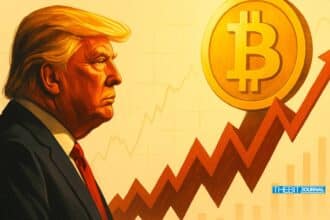The Bank of Italy has issued a warning that the Trump-era resurgence in digital asset prices, particularly involving Bitcoin and dollar-based stablecoins, could pose systemic threats to financial stability. The central bank’s April 2025 Financial Stability Report cites increasing market exposure to crypto-assets, revealing how platforms and investment vehicles based outside the eurozone are driving volatility in ways that could eventually ripple into traditional financial systems.
At the center of Italy’s concern are stablecoin risks, especially involving USD-backed tokens like Tether (USDT) and USD Coin (USDC), whose issuer reserves are heavily concentrated in short-term U.S. Treasury bills. According to the report, mass redemptions could trigger stress in U.S. bond markets, amplifying liquidity concerns across borders.
Dollar-Based Stablecoins Under Scrutiny as Global Usage Expands
Italy’s central bank points to the growing dominance of stablecoins pegged to the U.S. dollar in payment systems, savings applications, and investment funds. While such instruments have not yet reached systemic status within the eurozone, the report warns that unchecked expansion could shift control of liquidity away from central banks. The problem, officials say, lies not in the innovation itself, but in the lack of transparency and global regulatory oversight of the entities issuing and managing these tokens.

A particular concern is the reserve model employed by stablecoin providers. As of Q1 2025, Tether and Circle collectively hold over $120 billion in U.S. Treasury-backed assets. The Bank of Italy warned that large-scale redemptions, particularly during a risk-off event, could force sudden Treasury sales, destabilizing fixed-income markets and putting pressure on central bank operations globally.
Bitcoin ETFs and Offshore Platforms Add Another Layer of Risk
The crypto rally, sparked by Trump’s perceived support for digital assets, has also driven capital flows into Bitcoin ETFs and corporate treasuries. The Bank of Italy noted that over 60% of Bitcoin’s market capitalization is now tied to institutional channels such as ETF issuers, hedge funds, exchanges, and fintech firms.
These entities, primarily based in the U.S., Canada, and China, are operating beyond the reach of eurozone authorities.
The concern isn’t speculative trading alone, but the integration of crypto into corporate financing strategies. Some publicly traded firms are using Bitcoin to influence stock valuations or as collateral for debt instruments. Italian regulators see this blending of crypto risk into conventional capital markets as a fragile bridge that could collapse under liquidity strain.
European Regulators Push for Global Coordination
European authorities echoed Italy’s assessment. Christine Lagarde, President of the European Central Bank, cautioned that Europe’s Markets in Crypto-Assets Regulation (MiCAR) may not go far enough in isolating European markets from U.S.-driven crypto volatility. She highlighted that a widespread consumer shift into dollar-backed stablecoins could reduce the euro’s monetary autonomy and heighten foreign policy dependencies.
Natasha Cazenave, Executive Director of the European Securities and Markets Authority (ESMA), added that although crypto remains a fraction of global finance, its macro linkages are deepening faster than regulation can keep up. She pointed to increased consumer holdings of dollar-pegged assets via decentralized apps and custodians not subject to MiCAR enforcement.

In response, the European Banking Authority and ESMA have launched joint assessments on the liquidity risk models employed by offshore crypto service providers offering access to EU consumers. Italy is reportedly pushing for accelerated negotiations with the Financial Stability Board (FSB) and the International Organization of Securities Commissions (IOSCO) on joint crypto-risk frameworks.
Conclusion
Analysts say Trump’s crypto-friendly stance, including public endorsements of Bitcoin ETFs and private investments in digital asset ventures, has contributed to market exuberance and blurred the line between political support and regulatory neutrality. This political momentum, coupled with weak global regulatory cohesion, is creating a feedback loop of investor confidence that economic fundamentals may not support.
While MiCAR attempts to impose prudential requirements on EU-licensed stablecoin issuers, it has little influence on platforms like Tether, which are based in offshore jurisdictions. Italy’s report closes with a call for urgent cross-border action: “National tools will be insufficient to contain fallout from globally systemic stablecoin risks.”
FAQs
What are the main stablecoin risks mentioned in Italy’s report?
The Bank of Italy warned that stablecoins like USDT and USDC pose systemic risks due to their reliance on U.S. Treasury reserves. In the event of large redemptions, bond markets could be destabilized.
How does the EU plan to address stablecoin regulation?
The EU has introduced MiCAR, aiming to regulate crypto-assets and stablecoin issuers. However, authorities including the ECB believe further global coordination is necessary.
Are Bitcoin ETFs considered a financial threat?
According to Italy’s central bank, Bitcoin ETFs and similar institutional products are becoming vehicles for systemic exposure, especially when paired with volatile collateral strategies.
What’s the role of offshore platforms in the current crypto risk landscape?
Many major crypto entities operate outside EU jurisdictions, reducing regulatory visibility and heightening the risk of contagion through cross-border financial channels.
Glossary
Stablecoin: A type of cryptocurrency whose value is pegged to a stable asset, typically fiat currencies like the U.S. dollar.
MiCAR (Markets in Crypto-Assets Regulation): The EU’s comprehensive regulatory framework for crypto-assets, aimed at harmonizing rules across member states.
USDT (Tether): A major dollar-pegged stablecoin issued by Tether Limited.
USDC (USD Coin): A dollar-backed stablecoin issued by Circle, widely used for payments and DeFi applications.
Bitcoin ETF: An exchange-traded fund that tracks the price of Bitcoin and allows institutional and retail investors to gain exposure without holding the underlying asset.
Systemic Risk: The risk that the failure of one entity or market could trigger a broader collapse across the financial system.





























